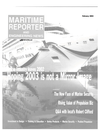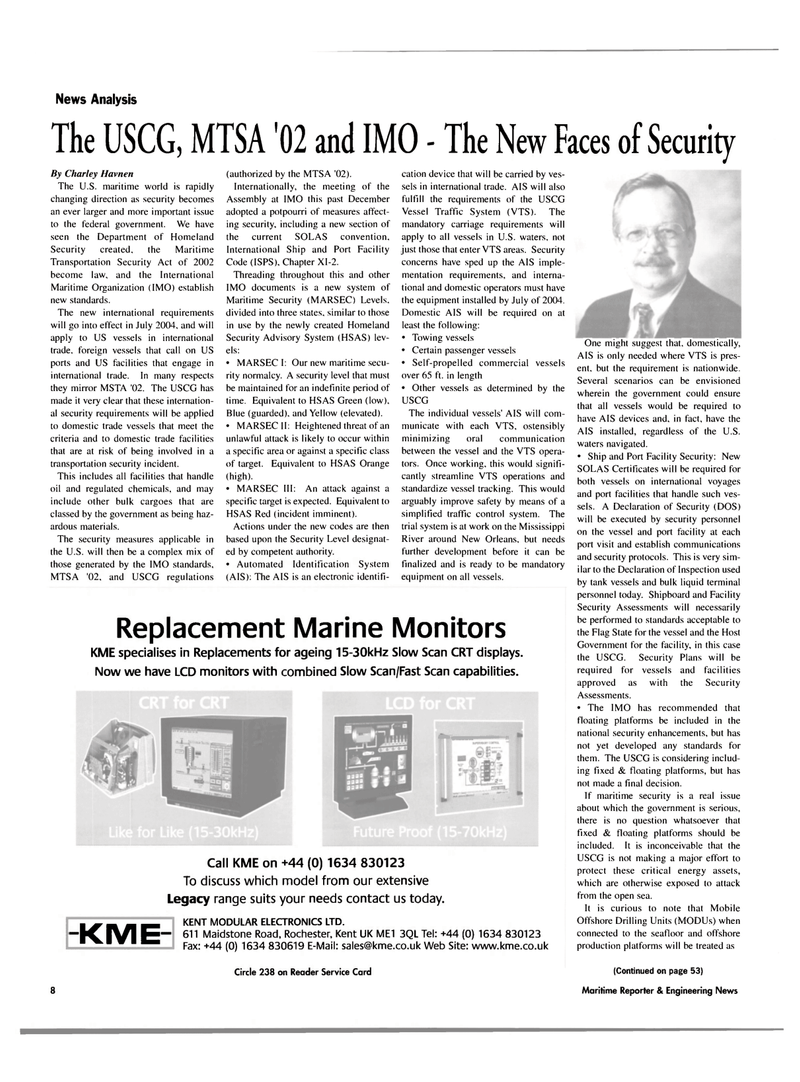
Page 8: of Maritime Reporter Magazine (February 2003)
Read this page in Pdf, Flash or Html5 edition of February 2003 Maritime Reporter Magazine
News Analysis
The USCG, MTSA '02 and IMO - The New Faces of Security
By Charley Havnen
The U.S. maritime world is rapidly changing direction as security becomes an ever larger and more important issue to the federal government. We have seen the Department of Homeland
Security created, the Maritime
Transportation Security Act of 2002 become law, and the International
Maritime Organization (IMO) establish new standards.
The new international requirements will go into effect in July 2004, and will apply to US vessels in international trade, foreign vessels that call on US ports and US facilities that engage in international trade. In many respects they mirror MSTA '02. The USCG has made it very clear that these internation- al security requirements will be applied to domestic trade vessels that meet the criteria and to domestic trade facilities that are at risk of being involved in a transportation security incident.
This includes all facilities that handle oil and regulated chemicals, and may include other bulk cargoes that are classed by the government as being haz- ardous materials.
The security measures applicable in the U.S. will then be a complex mix of those generated by the IMO standards,
MTSA '02, and USCG regulations -KME- (authorized by the MTSA '02).
Internationally, the meeting of the
Assembly at IMO this past December adopted a potpourri of measures affect- ing security, including a new section of the current SOLAS convention.
International Ship and Port Facility
Code (ISPS), Chapter XI-2.
Threading throughout this and other
IMO documents is a new system of
Maritime Security (MARSEC) Levels, divided into three states, similar to those in use by the newly created Homeland
Security Advisory System (HSAS) lev- els: • MARSEC I: Our new maritime secu- rity normalcy. A security level that must be maintained for an indefinite period of time. Equivalent to HSAS Green (low).
Blue (guarded), and Yellow (elevated). • MARSEC II: Heightened threat of an unlawful attack is likely to occur within a specific area or against a specific class of target. Equivalent to HSAS Orange (high). • MARSEC III: An attack against a specific target is expected. Equivalent to
HSAS Red (incident imminent).
Actions under the new codes are then based upon the Security Level designat- ed by competent authority. • Automated Identification System (AIS): The AIS is an electronic identifi- cation device that will be carried by ves- sels in international trade. AIS will also fulfill the requirements of the USCG
Vessel Traffic System (VTS). The mandatory carriage requirements will apply to all vessels in U.S. waters, not just those that enter VTS areas. Security concerns have sped up the AIS imple- mentation requirements, and interna- tional and domestic operators must have the equipment installed by July of 2004.
Domestic AIS will be required on at least the following: • Towing vessels • Certain passenger vessels • Self-propelled commercial vessels over 65 ft. in length • Other vessels as determined by the
USCG
The individual vessels' AIS will com- municate with each VTS, ostensibly minimizing oral communication between the vessel and the VTS opera- tors. Once working, this would signifi- cantly streamline VTS operations and standardize vessel tracking. This would arguably improve safety by means of a simplified traffic control system. The trial system is at work on the Mississippi
River around New Orleans, but needs further development before it can be finalized and is ready to be mandatory equipment on all vessels.
One might suggest that, domestically,
AIS is only needed where VTS is pres- ent, but the requirement is nationwide.
Several scenarios can be envisioned wherein the government could ensure that all vessels would be required to have AIS devices and, in fact, have the
AIS installed, regardless of the U.S. waters navigated. • Ship and Port Facility Security: New
SOLAS Certificates will be required for both vessels on international voyages and port facilities that handle such ves- sels. A Declaration of Security (DOS) will be executed by security personnel on the vessel and port facility at each port visit and establish communications and security protocols. This is very sim- ilar to the Declaration of Inspection used by tank vessels and bulk liquid terminal personnel today. Shipboard and Facility
Security Assessments will necessarily be performed to standards acceptable to the Flag State for the vessel and the Host
Government for the facility, in this case the USCG. Security Plans will be required for vessels and facilities approved as with the Security
Assessments. • The IMO has recommended that floating platforms be included in the national security enhancements, but has not yet developed any standards for them. The USCG is considering includ- ing fixed & floating platforms, but has not made a final decision.
If maritime security is a real issue about which the government is serious, there is no question whatsoever that fixed & floating platforms should be included. It is inconceivable that the
USCG is not making a major effort to protect these critical energy assets, which are otherwise exposed to attack from the open sea.
It is curious to note that Mobile
Offshore Drilling Units (MODUs) when connected to the seafloor and offshore production platforms will be treated as (Continued on page 53)
Replacement Marine Monitors
KME specialises in Replacements for ageing 15-30kHz Slow Scan CRT displays.
Now we have LCD monitors with :ombined Slow Scan/Fast Scan capabilities.
Call KME on +44 (0) 1634 830123
To discuss which model from our extensive
Legacy range suits your needs contact us today.
KENT MODULAR ELECTRONICS LTD. 611 Maidstone Road, Rochester, Kent UK ME1 3QL Tel: +44 (0) 1634 830123
Fax: +44 (0) 1634 830619 E-Mail: [email protected] Web Site: www.kme.co.uk
Circle 238 on Reader Service Card 8 Maritime Reporter & Engineering News

 7
7

 9
9
